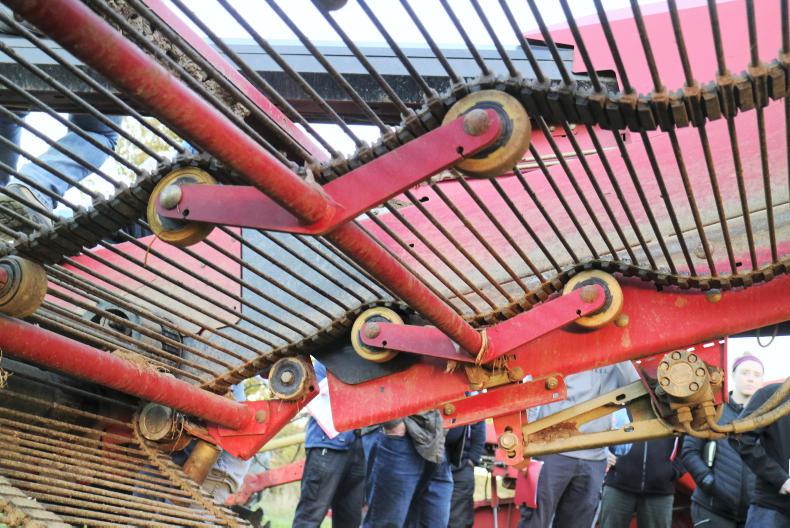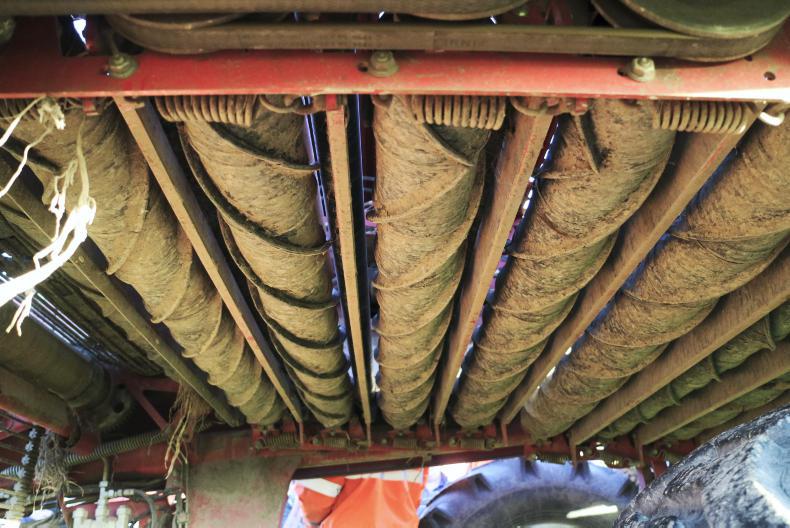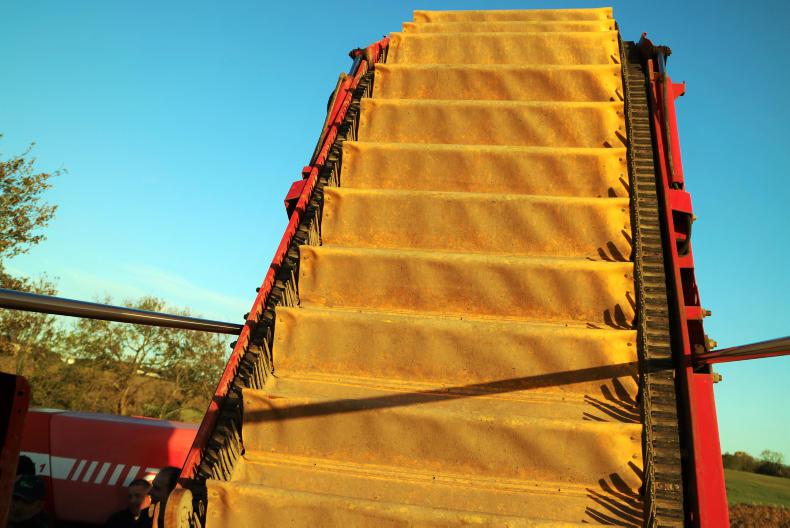The challenging year continues as the main potato harvest was delayed yet another week due to the rain from Storm Callum. Despite the extra cost incurred by growers this year and likely yields reduction, markets are holding firm and this year’s crops stand to be the most valuable since 2012.
Therefore growers can’t afford to lose any marketable crop this year at harvest time. The potato harvester can be a significant source of potato damage if set incorrectly. This article points out the top 10 areas where damage is likely to occur.
Listen to "Key point on a potato harvester to minimise damage" on Spreaker.
Spotting area of damage
Harvester damage can cause potato bruising, scuffing or splitting through rough handling, dropping them from a height or rubbing and hitting the potatoes against components of the harvester.
It is recommend to check samples of the crop regularly. Mechanical damage will be obvious but bruising may take some time to show.
By placing samples in a hot press or beside the kitchen stove overnight, any bruising in the crop will soon become apparent.
If finding the source of damage is proving difficult, then stopping the harvester mid-drill and collecting samples from locations within the harvester where damage is likely to occur (such as from the share, the web, the haulm separator and the elevator) and inspecting them for damage may help eliminate the problem.
Jamie Doyle of Grimme Ireland was on hand to discuss the main points to watch out for in the harvester which could cause damage at a recent Teagasc/IFA field walk in Balrothery, Co Dublin. While the discussion centred on a Grimme GT 170 trailed harvester, the points discussed will be relevant to any harvester.

Before checking any points on the harvester, ensure the haulm topper configuration is correct. The topper blades have basic row width settings but this don’t necessarily mean they will match the shape and depth of the potato drills. This could lead to the blades cutting into the drill and damaging the crops. Lifting the topper may prevent this but may also poorly fail the haulm, leading to damage further into the harvester. Ensure the blades adequately flail the crop.

The share width needs to be matched to the width of the bed to ensure the crop flows evenly and smoothly onto the web. Adjust the pitch of the share so that the blade is in line with the start of the web. Potatoes can be damaged if the share is set too low, causing them to hit the web. Potatoes can also be damaged if the share is set too high, causing them to drop when reaching the web.

The position and pressure of the diablo roller or rubber roller affects the flow of soil over the share. Too much pressure can compact the drill and cause the share to run shallower, possibly cutting or missing potatoes. Too little pressure can cause the share to push the soil in front of the diablo, altering the height of the share and causing an uneven feed into the web. Some growers have reported potatoes forming higher in the drill profile this year.

Ensure the discs are not set too narrow as they could cut through potatoes in the drill. If the discs are set too wide, this could cause stones or clods to carry onto the web. If the disk is set too deep, then this could make the share run shallow, cutting into potatoes. Be careful to ensure the width between the disk and the outer share isn’t too wide – no more that 20mm.

It is important to carry enough soil on the web in order to prevent potatoes rolling back and being damaged. One way to help with this is to decrease the web speed. Dry soil conditions have proven a challenge for some this year, making it difficult to carry soil on the web. Check for bent or worn bars which may cause potato damage and ensure the outer belting isn’t worn as potatoes may get trapped between the web and the side panel. Some growers have switched to narrower webs this year due to smaller than average potatoes.

Bent or worn bars may cause potato damage.

Web agitators can cause major damage if set too aggressive.
Web agitators can cause major damage if set too aggressively, if the crop is easily bruised or in dry conditions. Too much agitation can cause the soil to sieve through the webs too quickly and also cause potatoes to bounce on the web which will lead to bruising.

The haulm roller should be set in a less aggressive position.
The haulm roller should be set in a less aggressive position with feed fingers (if present) set higher to prevent damage. If haulm separation becomes as issue, raise the haulm roller to increase its aggressiveness and lower the feed fingers. When digging crop with large volumes of haulm, raise the feed fingers to prevent blockages.

Crop should be over the separators for the least amount of time as possible.
There are many different types of separators in cleaning units but, in general, crop should be over the separators for the least amount of time as possible. If the separators are set too slow, however, crop may build up in the machine. If they are set too fast, crop may bounce over the separators, causing damage.

The speed of the elevators should be as slow as possible in order to keep up with crop flow.
Elevator speed can also be a cause of damage. If the elevator speed is too high, this will throw potatoes into the trailer/box, causing significant damage. The pockets of the cart elevator should be around two-thirds full and the speed should be as slow as possible in order to keep up with crop flow.

When filling boxes, a chute can be fitted to the end of the elevator to reduce fall and damage.
Finally, when bulk filling into the trailer, ensure the elevator is as close as possible to the trailer bed in order to minimise the drop. Layer the bed of the trailer first, from front to back, then gradually fill the trailer. When filling boxes, a chute can be fitted to the end of the elevator to reduce fall and damage. Fill boxes from the middle.
Read more
Main potato harvest under way
IFA potato report: potato yields back but quality good
Watch: growers still awaiting final Diquat decision
The challenging year continues as the main potato harvest was delayed yet another week due to the rain from Storm Callum. Despite the extra cost incurred by growers this year and likely yields reduction, markets are holding firm and this year’s crops stand to be the most valuable since 2012.
Therefore growers can’t afford to lose any marketable crop this year at harvest time. The potato harvester can be a significant source of potato damage if set incorrectly. This article points out the top 10 areas where damage is likely to occur.
Listen to "Key point on a potato harvester to minimise damage" on Spreaker.
Spotting area of damage
Harvester damage can cause potato bruising, scuffing or splitting through rough handling, dropping them from a height or rubbing and hitting the potatoes against components of the harvester.
It is recommend to check samples of the crop regularly. Mechanical damage will be obvious but bruising may take some time to show.
By placing samples in a hot press or beside the kitchen stove overnight, any bruising in the crop will soon become apparent.
If finding the source of damage is proving difficult, then stopping the harvester mid-drill and collecting samples from locations within the harvester where damage is likely to occur (such as from the share, the web, the haulm separator and the elevator) and inspecting them for damage may help eliminate the problem.
Jamie Doyle of Grimme Ireland was on hand to discuss the main points to watch out for in the harvester which could cause damage at a recent Teagasc/IFA field walk in Balrothery, Co Dublin. While the discussion centred on a Grimme GT 170 trailed harvester, the points discussed will be relevant to any harvester.

Before checking any points on the harvester, ensure the haulm topper configuration is correct. The topper blades have basic row width settings but this don’t necessarily mean they will match the shape and depth of the potato drills. This could lead to the blades cutting into the drill and damaging the crops. Lifting the topper may prevent this but may also poorly fail the haulm, leading to damage further into the harvester. Ensure the blades adequately flail the crop.

The share width needs to be matched to the width of the bed to ensure the crop flows evenly and smoothly onto the web. Adjust the pitch of the share so that the blade is in line with the start of the web. Potatoes can be damaged if the share is set too low, causing them to hit the web. Potatoes can also be damaged if the share is set too high, causing them to drop when reaching the web.

The position and pressure of the diablo roller or rubber roller affects the flow of soil over the share. Too much pressure can compact the drill and cause the share to run shallower, possibly cutting or missing potatoes. Too little pressure can cause the share to push the soil in front of the diablo, altering the height of the share and causing an uneven feed into the web. Some growers have reported potatoes forming higher in the drill profile this year.

Ensure the discs are not set too narrow as they could cut through potatoes in the drill. If the discs are set too wide, this could cause stones or clods to carry onto the web. If the disk is set too deep, then this could make the share run shallow, cutting into potatoes. Be careful to ensure the width between the disk and the outer share isn’t too wide – no more that 20mm.

It is important to carry enough soil on the web in order to prevent potatoes rolling back and being damaged. One way to help with this is to decrease the web speed. Dry soil conditions have proven a challenge for some this year, making it difficult to carry soil on the web. Check for bent or worn bars which may cause potato damage and ensure the outer belting isn’t worn as potatoes may get trapped between the web and the side panel. Some growers have switched to narrower webs this year due to smaller than average potatoes.

Bent or worn bars may cause potato damage.

Web agitators can cause major damage if set too aggressive.
Web agitators can cause major damage if set too aggressively, if the crop is easily bruised or in dry conditions. Too much agitation can cause the soil to sieve through the webs too quickly and also cause potatoes to bounce on the web which will lead to bruising.

The haulm roller should be set in a less aggressive position.
The haulm roller should be set in a less aggressive position with feed fingers (if present) set higher to prevent damage. If haulm separation becomes as issue, raise the haulm roller to increase its aggressiveness and lower the feed fingers. When digging crop with large volumes of haulm, raise the feed fingers to prevent blockages.

Crop should be over the separators for the least amount of time as possible.
There are many different types of separators in cleaning units but, in general, crop should be over the separators for the least amount of time as possible. If the separators are set too slow, however, crop may build up in the machine. If they are set too fast, crop may bounce over the separators, causing damage.

The speed of the elevators should be as slow as possible in order to keep up with crop flow.
Elevator speed can also be a cause of damage. If the elevator speed is too high, this will throw potatoes into the trailer/box, causing significant damage. The pockets of the cart elevator should be around two-thirds full and the speed should be as slow as possible in order to keep up with crop flow.

When filling boxes, a chute can be fitted to the end of the elevator to reduce fall and damage.
Finally, when bulk filling into the trailer, ensure the elevator is as close as possible to the trailer bed in order to minimise the drop. Layer the bed of the trailer first, from front to back, then gradually fill the trailer. When filling boxes, a chute can be fitted to the end of the elevator to reduce fall and damage. Fill boxes from the middle.
Read more
Main potato harvest under way
IFA potato report: potato yields back but quality good
Watch: growers still awaiting final Diquat decision

















 This is a subscriber-only article
This is a subscriber-only article









SHARING OPTIONS: